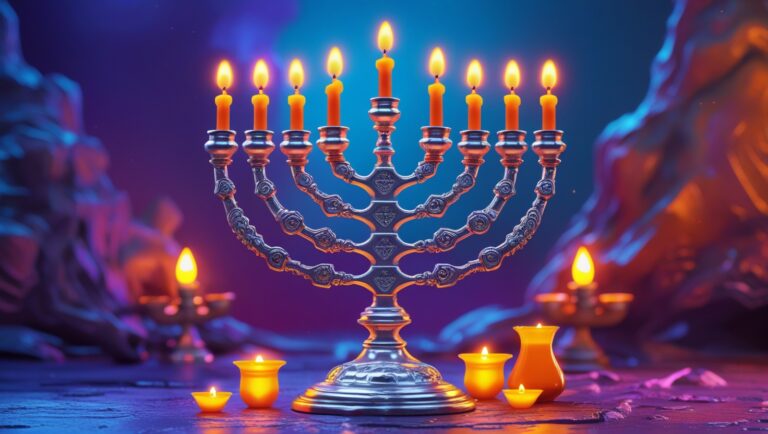The art of Niggun, deeply embedded in the Hasidic tradition, represents a unique and spiritually uplifting experience that transcends the mundane through singing.
A niggun is a wordless melody, varying from simple to complex, slow and meditative to fast and jubilant. These melodies are repeated over and over, serving as mystical prayers intended to deepen access to the soul, expand the spirit, and enflame one with desire for Avodat Hashem.
The origins of niggunim date back to the 18th-century Hasidic movement, which revolutionized Jewish musical expression by giving greater emphasis for melody in life. This shift was spearheaded by Rabbi Israel Baal Shem Tov, the founder of Hasidism, who emphasized vocal music as a form of personal confession and spiritual expression. He viewed song as a more significant form of spiritual expression than traditional prayer, a pathway to God that transcended language limitations.
As we know, certain truths defy verbal articulation (Binah), particularly those rooted in experiential knowledge (Chokhmah), arguably the most profound form of grasping reality. These truths are innate, recognized by an individual as inherently true, embodying the concept of “secrets of Torah” — And here we don’t say secrets because their sharing is forbidden, but because their essence cannot be conveyed through teaching.
For instance, the essence of love or the perception of color to someone who has never felt or seen them is beyond mere explanation.
A niggun, or spiritual melody, serves as a powerful conduit to the soul’s deeper layers, revealing truths that often elude our conscious awareness. It reminds us of our intrinsic holiness, the omnipresence of Hashem even amidst our imperfections, our significance, and the purpose within our trials.
The Rav Eliezer Berland as well as many others including the Chatam Sofer write that only prayer that is sung truly ascends and has the power to be more readily accepted by Hashem.
Niggun in Chassidic tradition
This idea was continued and expanded upon by subsequent Hasidic leaders, such as Rabbi Nachman of Breslov, who believed music originated from the prophetic spirit and had the power to elevate one to prophetic inspiration. This is in line with Rabbi Chaim Vital’s teaching in Shaarei Kedusha that “almost the entirety of the process of reaching Ruach HaKodesh is by being happy constantly” (as he received from the Arizal).
Different Hasidic dynasties have developed their own styles of niggunim, reflecting their distinct spiritual paths. For instance, the Breslov community is known for its emotional creativity, while the Kaliver Dynasty, starting with Rabbi Yitzchak Isaac Taub, often adapted Hungarian folk songs, infusing them with Jewish words and spiritual meanings.
Niggunim serve various purposes within the Hasidic tradition. They can be meditative devekut nigunim, rhythmic dance tunes, or complex tisch nigunim sung at Shabbat or holiday meals. Regardless of their form, niggunim are powerful tools for psychological and spiritual effect, enabling individuals to connect with Hashem through music.
The repetitive nature of niggunim, coupled with their deep emotional resonance, can have a calming and restorative effect on the mind and spirit. This aspect is especially poignant in times of personal or communal distress, providing solace and a sense of comfort amidst suffering or despair.
And, as we know, אין שום יאוש בעולם כלל: “There’s no despair in the world at all” (Rebbe Nachman of Breslov).
The Niggun of Yaakov Avinu
This comes from Sefer HaPesukim from the Arizal:
When Yaakov Avinu’s sons return from Egypt bearing the distressing news that Shimon has been detained by the viceroy—unbeknownst to them, Yosef HaTzaddik himself. Jacob, already bereft of one son, faced the harrowing prospect of sending Binyamin with them, thereby risking even more. It was Yehuda who ultimately persuaded his father that Binyamin would be well cared for and returned safely.
Amidst his sorrow, Yakov Avunu’s response was peculiar; he advised his sons to take “some of the choice products of the land” as a gift for the viceroy, including balm, honey, gum, ladanum, pistachio nuts, and almonds.
This directive prompts several questions: How could these simple gifts sway the most powerful man in Egypt? Did Yaakov believe that Egypt, known for its wealth, lacked these commodities? What prompted him to gamble with Binyamin’s safety?
The key lies in the nuanced interpretation of “choice products” (זמרת, zimrat), which can also signify ‘music’ or ‘melody’, as a singer in Hebrew is referred to as a Zamar. The Arizal, in Sha’ar HaPesukim, notes that the brothers described the viceroy as being accompanied by a formidable, accusatory angel. Jacob realized that to soften the viceroy’s heart and mitigate the angel’s influence, they needed more than physical gifts; they required the power of a Nigun (melody), supplemented by God’s holy names encoded within the names of the food items.
This concept is explored in depth in Likutey Moharan by Rebbe Nachman of Breslov, highlighting the transformative power of melody and spirituality embedded in seemingly mundane offerings.
Nigun as a Form of Meditation
Prominent Mussar and Kabbalistic scholars advocate for a profound yearning towards Hashem, akin to the longing felt for a cherished one. Although challenging, this spiritual endeavor is attainable with dedicated effort. It’s closer than we often give credit for.
The Rambam, in his Mishneh Torah, counsels that contemplation on the marvels of Creation ignites a love and reverence for the Creator, a crucial step in drawing nearer to Him. Rabbi Chaim Vital, in Sha’arei Kedusha, emphasizes the importance of maintaining an unceasing awareness of the Shekhinah (Hashem’s immanent divine presence), a concept known as Devekut (bonding), which marks the commencement of genuine divine understanding which we explored many times here.
The Nigun serves as a powerful tool for introspection, enabling one to transcend external distractions and focus solely on spiritual aspirations. It is a personal journey to discover the melody that resonates with one’s soul and the appropriate moments for its expression. There’s nothing saying a person cannot create his own Niggun. Whether it will be accepted by others is another story but I believe one should do whatever helps him in Avodat Hashem, provided it’s in line with the Torah.
These melodies are designed to be repetitive, allowing the singer to enter a meditative state. In this state, the barriers of rational thought can diminish, opening up new avenues for spiritual and emotional insights.
Kabbalistic books, mainly the Etz Chaim (Tree of Life), explain the correspondence of the four spiritual realms (Atzilut, Beriyah, Yetzirah, and Assiyah) with the four elements of Torah annotation: Ta’amim (cantillation marks), Nekudot (vowel points), Taguin (crowns), and Otiot (letters). Given its melodic nature, akin to the Ta’amim, nigunim are often associated with the realm of Atzilut, representing the pinnacle of devekut and spiritual practice.
This is why many Chassidic leaders have crafted their melodies during moments of profound Devekut, yet the creation of personal nigunim is not only reserved for the spiritually elevated; it is a practice I believe should be encouraged for all.
Concluding remarks
Niggunim, often simple yet deep, transcend language and intellectual comprehension, offering a pathway to heightened spiritual awareness and deeper insights. We should also add that, when combined with dance, the power of niggunim is significantly amplified, engaging the body and soul in a holistic expression of devotion and joy. The body must also join as it has its own consciousness that often weighs us down.
It goes without saying that the act of singing a niggun, especially in a communal setting, can have a compounding effect on the mind. When one dances to a niggun, the physical movement combined with the melody can lead to the state of “devekut” more easily. This state is not just an emotional high; it is a deeply spiritual experience that can lead to new levels of consciousness and understanding.
May we each uncover the nigunim within our souls, drawing ever closer to Hashem.







